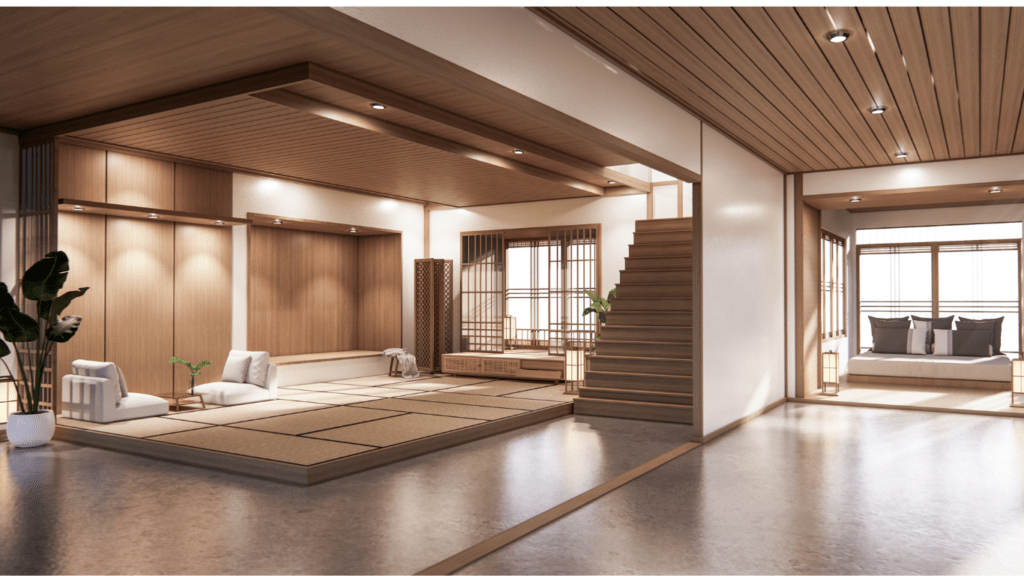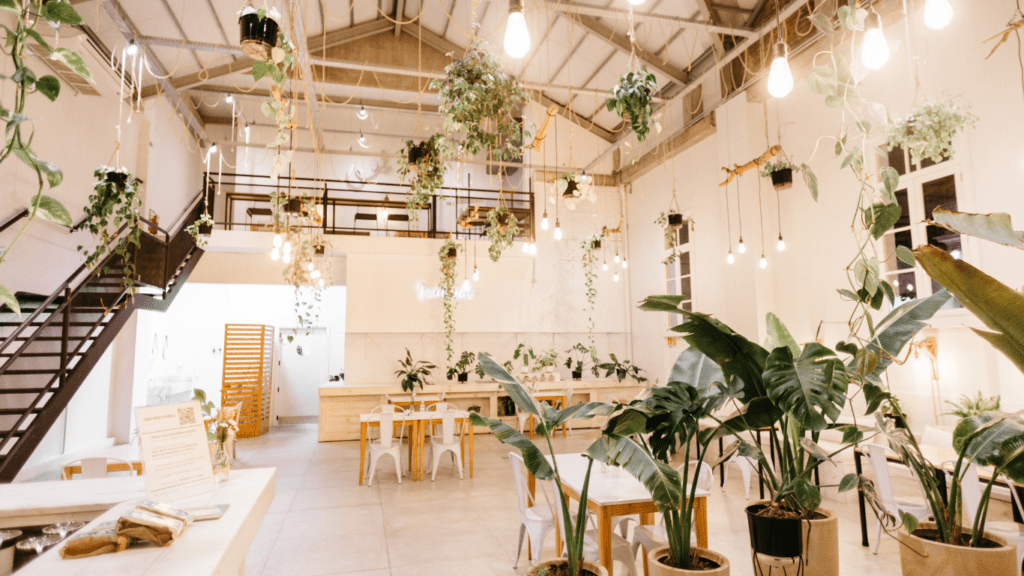The Essence of Japandi Design
Japandi design merges Japanese minimalism and Scandinavian functionality. It makes use of clean lines, natural materials, and a muted color palette. This fusion provides a calming yet stylish environment.
Minimalism
Japandi design prioritizes minimalism, with uncluttered spaces and purposeful items. Furniture pieces often showcase sleek silhouettes and functional designs. For example, low-profile sofas and simple wooden tables.
Natural Materials
Wood, stone, and natural fibers define Japandi interiors. These materials add texture and warmth, enhancing the serene ambiance. Light woods like oak, along with bamboo and cotton, are common choices.
Muted Color Palette
A muted color palette characterizes Japandi design. Neutral tones, such as beige, gray, and white, dominate, with occasional dark accents. This palette enhances the sense of tranquility and space.
Functional Decor
Functionality is central in Japandi decor. Each piece serves a purpose, often with dual functions. For instance, a bench may offer seating and storage, exemplifying practical elegance.
Indoor-Outdoor Connection
Japandi design emphasizes a strong connection with nature. Large windows, indoor plants, and natural light help to achieve this integration. The goal is to create a seamless flow between indoor and outdoor spaces.
Simplicity and Elegance
Combining simplicity and elegance, Japandi design avoids excess. Less is more, with each item chosen for its beauty and utility. This approach creates harmony and balance in living spaces.
Key Principles of Japandi Style
Japandi style harmoniously blends Japanese minimalism with Scandinavian functionality. Key principles include minimalism, functionality, and nature-inspired elements.
Minimalism
Japandi style emphasizes minimalist design, focusing on simplicity and elegance. Neutral tones like beige and gray dominate, creating a serene environment. Uncluttered spaces with purposeful items, such as sleek furniture and minimal decor, are essential. For instance, low-profile sofas and simple wooden tables ensure both form and function are prioritized.
Functionality
Functionality is central to Japandi decor. Every piece serves a specific purpose, often with dual functions. For instance, modular furniture like storage benches and foldable tables optimize space. The design ensures that homes are practical yet stylish, catering to modern living needs without sacrificing aesthetics.
Nature-Inspired Elements
Japandi design incorporates nature to enhance tranquility. Natural materials like:
- wood
- stone
- fibers
add texture and warmth. Large windows and indoor plants create a seamless connection between indoor and outdoor spaces. For example, woven baskets and wooden planters reinforce this natural aesthetic, promoting a harmonious living environment.
Core Elements in Japandi Interiors

Japandi interiors blend Japanese minimalism with Scandinavian simplicity, creating serene and functional spaces. The core elements in Japandi interiors focus on intentional designs that merge form and function.
Furniture
Japandi furniture emphasizes sleek, low-profile pieces with clean lines. Examples like low sofas, simple wooden tables, and clean-legged chairs dominate Japandi spaces, providing a sense of openness. Dual-function furniture such as storage benches and modular sofas is prevalent, maximizing utility in minimalist ways. Light-colored wood, often in oak or bamboo, adds warmth and texture.
Color Palette
Japandi interiors feature a muted color palette dominated by neutral tones. Shades of beige, gray, and white create a calming backdrop. Soft pastels and earthy hues like sage green or terracotta occasionally accent the design, adding subtle contrast. This restrained palette reinforces Japandi’s minimalist ethos, promoting a tranquil atmosphere.
Japandi in Different Spaces
Adopting the Japandi design in various spaces of your home can create a cohesive, peaceful environment. Here’s how to integrate this blend of Japanese and Scandinavian aesthetics in specific areas.
Living Room
Japandi principles transform the living room into a calm retreat. Use a minimalist approach with essential pieces like a low-profile sofa, a simple coffee table, and a clean-lined media console. Natural materials dominate—opt for wooden furniture, woven baskets, and stone decor. Keep the color palette neutral with beige, gray, and white with touches of soft pastels. Incorporate functional decor like storage ottomans that double as seating. Large windows and indoor plants connect the interior with nature.
Bedroom
In the bedroom, Japandi emphasizes tranquility and simplicity. Choose a low wooden platform bed with crisp, white linens. Keep furnishings minimal—a bedside table, a dresser, and maybe a simple chair. The palette stays muted with soft earthy tones contributing to the serene ambiance. Materials like bamboo or linen for curtains and cushions add texture. Integrate practical storage solutions to reduce clutter, such as under-bed drawers or a built-in wardrobe. Large windows or sliding doors can offer a seamless transition to the outdoor space, enhancing the sense of calm.
Kitchen
Japandi’s functionality shines in the kitchen. Prioritize sleek, clean lines with built-in cabinets and open shelving. Stick to neutral colors—white cabinetry, light wood floors, and stone countertops. Choose functional yet beautiful kitchen tools and accessories, like ceramic dishware and wooden cutting boards, to keep the space uncluttered. Natural elements can include potted herbs or small plants. Integrated appliances keep the kitchen streamlined without sacrificing utility, ensuring a balance between aesthetic appeal and practical use.
Incorporating Japandi in these key spaces aligns your home with the principles of minimalism, functionality, and a connection with nature.
Tips for Achieving a Japandi Aesthetic
To create a Japandi-inspired space, it’s essential to focus on and blend minimalist design elements and cozy touches seamlessly.
Choosing the Right Materials
- Select natural materials for an authentic Japandi look. Use wood, stone, and natural fibers generously.
- Incorporate light woods like oak, ash, and pine for furniture and flooring.
- Opt for stone countertops and backsplashes in the kitchen to add texture.
- Integrate natural fibers like cotton, linen, and jute in textiles and rugs.
- These choices bring warmth and authenticity to the space.
Balancing Simplicity and Comfort
Prioritize clean lines and uncluttered spaces while ensuring the space feels inviting. Use streamlined furniture with simple silhouettes to maintain minimalism. Add plush cushions, throws, and soft textiles for comfort. Select a neutral color palette with muted tones, and add warmth with soft pastels and earthy hues. Thoughtfully place a few décor items like ceramic vases or woven baskets to enhance coziness without cluttering the space.
.



 Lead Interior Design Expert
Maud Berthold is Luxe House Maker’s lead interior designer, bringing over a decade of experience in creating luxurious and functional living spaces. Specializing in the art of blending timeless elegance with modern sensibilities, Maud’s designs are known for their sophistication and attention to detail. She works closely with clients to craft interiors that reflect their personal tastes while adhering to the highest standards of luxury. From high-end furniture to custom décor, Maud ensures that each project is an exquisite balance of form and function, making her a key asset to the Luxe House Maker team.
Lead Interior Design Expert
Maud Berthold is Luxe House Maker’s lead interior designer, bringing over a decade of experience in creating luxurious and functional living spaces. Specializing in the art of blending timeless elegance with modern sensibilities, Maud’s designs are known for their sophistication and attention to detail. She works closely with clients to craft interiors that reflect their personal tastes while adhering to the highest standards of luxury. From high-end furniture to custom décor, Maud ensures that each project is an exquisite balance of form and function, making her a key asset to the Luxe House Maker team.
